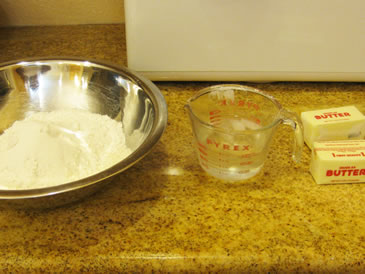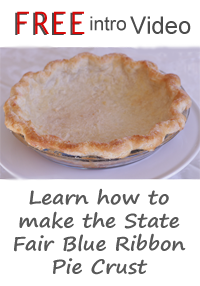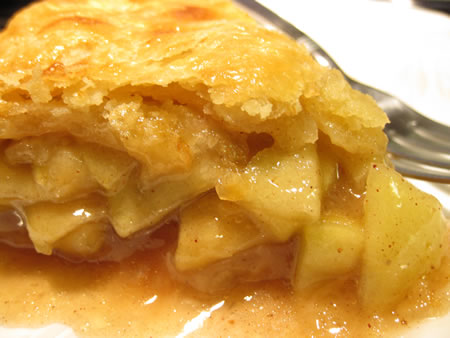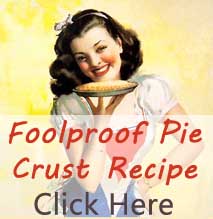Understanding Pie Crust Ingredients, Step by Step and more…
Posted by Warren
Know what is in your pie crust recipe.

There are four
basic ingredients
in a pie crust
Flour, Fat, Water and Salt.
There are four basic ingredients in a pie crust; Flour, Fat, Water and Salt. You can come up with all kinds of tasty variations just by changing these four basic ingredients as long you stick to the ratio of three parts flour, two parts fat, and one-half part liquid with a few pinches of salt.
Pie Crust Recipe Ratio:
three parts flour,
two parts fat,
one-half part liquid.
The best way for you to make a good crust is to understand the ingredients that goes into the recipe. What they contain and how they react with each other.
Theory is one thing, practice is another. The goal is to give you the skills to bake a perfect homemade pie crust. You must do your part and practice.
The Flour –
For a tender crust pick a low protein flour. Pastry flour with a protein content of about 8 to 10% is ideal for pie crust. This positions it between all-purpose flour and cake flour.
All purpose flour works fine for most pies. Cake flour alone lacks enough protein to form a workable, elastic dough.
Making your own
pastry flour.
Cake flour is too high in starch, so it will not absorb enough water and produce a pasty enough dough.
Bread flour because of its high protein content, will absorb water quickly and develop gluten in great amounts. This will make a dough that it’s tough and elastic and sticky.
Pastry flour and all-purpose flour have the proper balance of starch and protein. These flours have the desire amount of water absorption and gluten development to create a dough that is both flaky and tender.
The Fat –
Fat contributes to the flaky texture in pastry dough. The amount of fat and the way it is added to the ingredients will determine if the dough will turn out a flaky or mealy crust.
Leaving the fat in pieces or chunks, rather than combining thoroughly, gives a dough s flaky texture. When the dough bakes the pieces of fat melt to create pockets or voids in the crust, generating flakes. The larger the fat pieces are the flakier the crust becomes.
Butter, lard, and hydrogenated shortening like CRISCO may be used for a flaky crust. All of these fats are solid at room temperature, and hardens or solidify when cold.
Of all the fats butter alone yield the most flavor, but it is difficult to handle because it has a lower melting point than shortening or lard.
Grade A and AA butters
contain only 81% fat, 29% water.
Butter creates the best flavor in pie crust but is difficult to work with. Do not use low quality butters or reduced fat brands since these contain more water and will produce a less tender crust.
Lard produces the flakiest crust but processed lard can have a chemical aftertaste. If all possible it is best to use leaf lard. Lard is 100% fat and 0% water.
Use
Leaf Lard
Vegetable shortening is easy to work with and hold their shape better than all butter crusts, but lack richness in flavor.
Fans of crispier crust use oil or melted butter, resulting in a mealy crust that bakes a fine textured, a crisp crust which tends to work well for custards and refrigerated pies.
The Liquid –
Liquid or water (most common) is the binding agent of your dry ingredients. Without liquids, the proteins in the flour can not connect to form the gluten structure necessary for binding the dough together.
If your water has
a lot of chlorine or smells,
use bottled water.
Your liquid can include fruit juices, sour cream, milk, eggs or liquor. Without water, gluten does not develop, which is needed to keep the pie crust from falling apart and becoming too crumbly.
Acidity liquids like vinegar help weaken the gluten making the dough more pliable which allows for easier rolling.
The Salt and Sugar –
Salt and sugar are needed to enhance the flavor of your crust. Salt is vital to all baking and pastry endeavours. Salt just makes everything taste better.
To every cup of flour
add 1/4 teaspoon of salt.
Salt counteracts bitterness so adding just a little can make the perception of sweetness. Salt adds flavor and dimension to baked goods. If your pie crust is flat and bland tasting, chances are you did not use salt in the dough.
Sugar does a number of things in baked goods. It inhibits the development of gluten making a more tender crust. It is hygroscopic meaning it draws water to it. This helps to keep things moist and fresh. And sure, sugar makes the pie crust taste sweet.
Now you have it. You know all about your pie crust ingredients needed to build a perfect flaky pie crust. Let’s learn how to mix the pie crust ingredients the right way, the all important technique.



